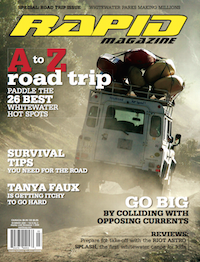There was a logbook, covered in dust with the spine worn bare, that for years greeted expedition canoeists when they reached Fort Albany. The register was an end-of-trip ritual for canoeists who had finally made it to James bay. Sign your name, enter the date, and add a comment or two. The entries ranged from expressions of gratitude for being finished, to remorse for a trip that had ended.
But it’s what’s not written down, the story that isn’t told, that speaks louder than the pencil scratch on the page.
Bruce Hodgins—author, historian, retired professor and, with a personal canoe resume that reaches back to the 1950s, one of the architects of Canada’s canoe culture—is a man who knows about what is and isn’t found in canoeing logbooks and trip journals. Hodgins teamed up with fellow historian Gwyneth Hoyle to research the recent history of canoe travel and put it in one place. The result is the remarkable Canoeing North into the Unknown, A Record of River Travel: 1874 to 1974 (Natural Heritage, 1994), a seminal collection of the who, what, when and where of canoe tripping history.
You would not sit down and read hodgins’ and hoyle’s book from cover to cover. It’s a resource, a list of dates and names, with minimal description or qualification. entries receive equal billing and range from the famous:
“1789 Alexander Mackenzie, on his fifth crossing of the Methye Portage, travelled north, all the way down the Mackenzie River to the Arctic ocean.”
To the mundane:
“1974 Camp kandalore: John Fallis and guy Delaire led a boys group down the Missininaibi River to Moose Factory.”
To the epic:
“1930 Eric Sevareid, 17, and Walter Port, 19, canoed from their home in Minneapolis to York Factory—a total of 2,250 miles.”
I spoke with hodgins this spring. He was preparing to run the Irondale River in Ontario’s Kawartha region, even though at 75 years of age and with heart problems, his doctor no longer allows him to portage his own canoe.
I wanted to ask him about something that was missing in Canoeing North into the Unknown. It’s the same thing missing from the Fort Albany register, and that was why. Why did all those people take to the north at a time when access was difficult, trips were expensive and canoeing for pleasure was considered foolhardy? The names and dates share little of what the trip was about; the motivation, the experience as it unfolded, the stories, and the memories. What was it these people were seeking?
As Hodgins points out, in the early days of recreational tripping, canoers didn’t know much about the rivers they were travelling until they got on them. They were heading somewhere, unsure of what they would find. Hodgins thinks this is at once the reason they didn’t explain their motives, and also their motivation for going.
I prompted him with a line from the introduction to his book: “For some, the long northern river voyage is part of a quest pattern, a challenge, an exploration…a journey into the unknown.”
“Absolutely,” said Hodgins. “There is an emotional element to tripping on rivers, a re-experiencing of wonder as you discover something that was un- known to you. gwyneth was right to put “unknown” in the title. It’s the seeking out of something unknown that engages the individual.”
Hodgins’ book is intriguing because in it you don’t actually read about the quest for the unknown, but you know it is there. You can feel it from the lack of information that describes the simple trip details. For each entry there is a profound story left untold.
While the early explorers were charting vast wilderness, today’s paddlers are on their own search for something unknown to them. Pouring over a map, watching the weather, and nervously anticipating what’s around the next bend is part of the discovery on a canoe expedition. It is a personal quest, that can be discerned in trip journals, but only if you know what to look for. A camp’s map coordinates could be meticulously logged, followed by a scrawled, “The most beautiful place on earth.” Notes on an unplanned portage are followed by, “The hardest day of my life.” while short on detail, these simple lines speak volumes about the writer’s motivation; the why. The desire to challenge oneself by confronting the unknown is ultimately personal, and can only be hinted at in a few short sentences in a dusty register.
I asked Hodgins if the theme of a quest to explore the unknown persisted intact over the course of the last century and a half of canoe travel.
“Ah, yes, I still believe that the quest for the unknown is an element of why people do it,” hodgins replied, as he buckled the strap on his canoe pack and placed it by the door. It would be ready for him to pick up in the morn- ing as he went out again to experience something, something he wasn’t quite sure of yet. Those who wrote journals in the past, or will keep one in the future, likely would not admit to this emotional quest—it certainly isn’t written down anywhere in the Fort Albany journal— but it is there, between every line.
Jeff Jackson is a professor of outdoor adventure at Algonquin College in Pembroke, Ontario.
 This article first appeared in the Summer 2006 issue of Rapid Magazine. For more great content, subscribe to Rapid’s print and digital editions here.
This article first appeared in the Summer 2006 issue of Rapid Magazine. For more great content, subscribe to Rapid’s print and digital editions here.



